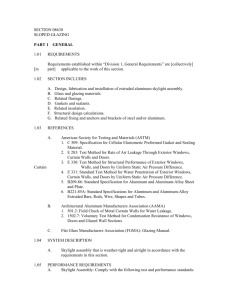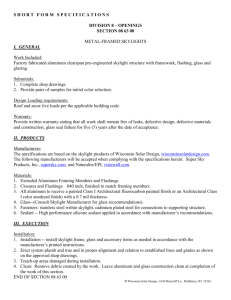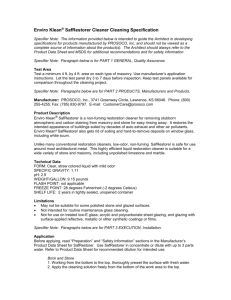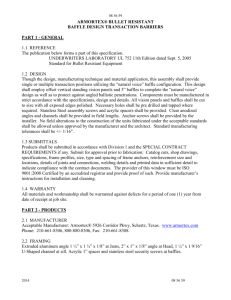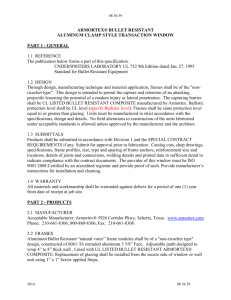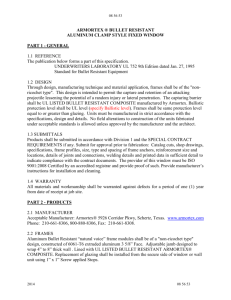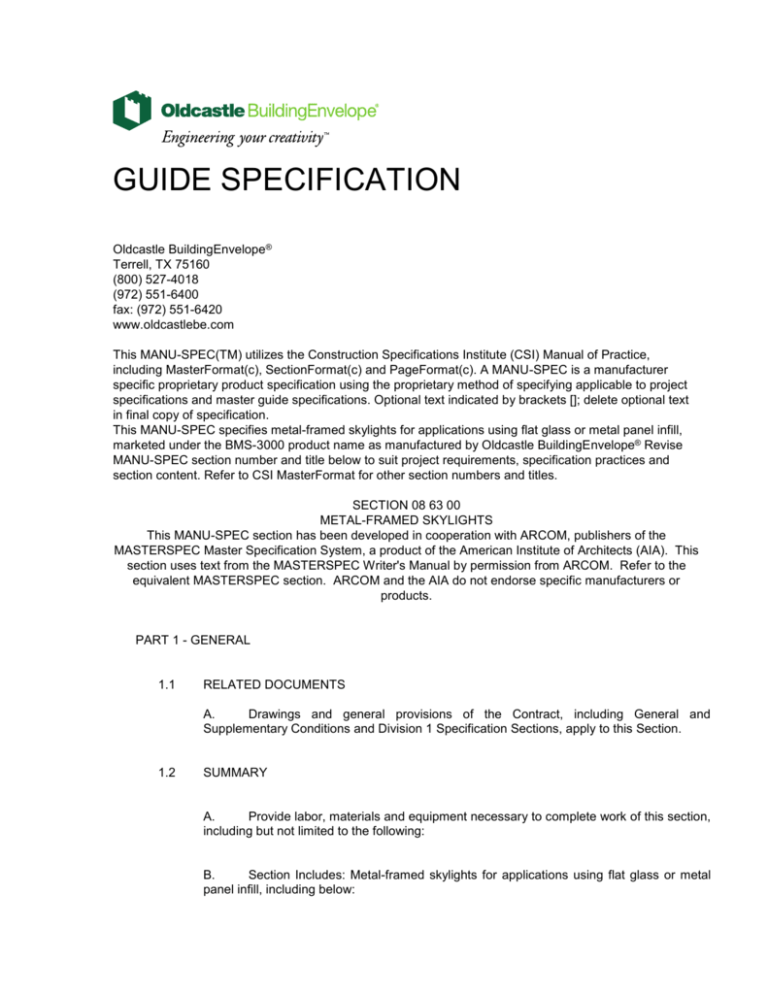
GUIDE SPECIFICATION
Oldcastle BuildingEnvelope®
Terrell, TX 75160
(800) 527-4018
(972) 551-6400
fax: (972) 551-6420
www.oldcastlebe.com
This MANU-SPEC(TM) utilizes the Construction Specifications Institute (CSI) Manual of Practice,
including MasterFormat(c), SectionFormat(c) and PageFormat(c). A MANU-SPEC is a manufacturer
specific proprietary product specification using the proprietary method of specifying applicable to project
specifications and master guide specifications. Optional text indicated by brackets []; delete optional text
in final copy of specification.
This MANU-SPEC specifies metal-framed skylights for applications using flat glass or metal panel infill,
marketed under the BMS-3000 product name as manufactured by Oldcastle BuildingEnvelope® Revise
MANU-SPEC section number and title below to suit project requirements, specification practices and
section content. Refer to CSI MasterFormat for other section numbers and titles.
SECTION 08 63 00
METAL-FRAMED SKYLIGHTS
This MANU-SPEC section has been developed in cooperation with ARCOM, publishers of the
MASTERSPEC Master Specification System, a product of the American Institute of Architects (AIA). This
section uses text from the MASTERSPEC Writer's Manual by permission from ARCOM. Refer to the
equivalent MASTERSPEC section. ARCOM and the AIA do not endorse specific manufacturers or
products.
PART 1 - GENERAL
1.1
RELATED DOCUMENTS
A.
Drawings and general provisions of the Contract, including General and
Supplementary Conditions and Division 1 Specification Sections, apply to this Section.
1.2
SUMMARY
A.
Provide labor, materials and equipment necessary to complete work of this section,
including but not limited to the following:
B.
Section Includes: Metal-framed skylights for applications using flat glass or metal
panel infill, including below:
Specifier Note: Edit paragraphs below to suit project requirements.
1. Structural design, engineering and fabrication of complete metal framed skylight
system, including aluminum framing, integral closures, trim, perimeter flashing and
surface reglets as indicated on drawings.
2. Glass and glazing for metal framed skylight system including gaskets, sealants,
spacers, blocking and related materials.
3. Fasteners, anchors and related reinforcement of framing system as required to resist
design loads.
Specifier Note: Edit paragraph below. Motor operated skylight applications requires feasibility study by
during project design phase.
Specifier Note: Revise paragraph below to suit project requirements. Add section numbers and titles per
CSI MasterFormat and specifier's practice.
C.
Related Sections: Section(s) related to this section include:
1. Structural Steel: Division 5 - Structural Steel.
2. Space Frames: Division 5 - Space Frame Section.
3. Metal Fabrications: Division 5 - Metal fabrications Section.
4. Flashing and Sheet Metal: Division 7 - Flashing and Sheet Metal Section.
5. Joint Sealers: Division 7 - Joint Sealers Sections.
6. Glazing: Division 8 - Glass and Glazing Section.
7. Glazed Curtain Walls: Division 8 - Glazed Curtain Wall.
8. Window Treatment: Division 12 - Window Treatment.
Specifier Note: Article below may be omitted when specifying manufacturer's proprietary products and
recommended installation. Retain Reference Article when specifying products and installation by an
industry reference standard. If retained, list standard(s) referenced in this section. Indicate issuing
authority name, acronym, standard designation and title. Establish policy for indicating edition date of
standard referenced. Conditions of the Contract or Division 1 References Section may establish the
edition date of standards. This article does not require compliance with standard, but is merely a
listing of references used. Article below should list only those industry standards referenced in this
section.
Note for REFERENCES Article - IF PERTINENT
Specifier's Note: References are not used in MASTERSPEC? . This section is retained from the MANUSPEC section of that title.
1.3
REFERENCES
A.
General: Standards listed by reference, including revisions by issuing authority,
form a part of this specification section to extent indicated. Standards listed are identified
by issuing authority, authority abbreviation, designation number, title or other designation
established by issuing authority. Standards subsequently referenced herein are referred to
by issuing authority abbreviation and standard designation.
B.
American Society for Testing and Materials (ASTM):
1. ASTM C509 Cellular Elastomeric Preformed Gasket and Sealing Material.
2. ASTM C794 Test Method for Adhesion-in-Peel of Elastomeric Joint Sealants.
3. ASTM C864 Dense Elastomeric Compression Seal Gaskets, Setting Blocks and
Spacers.
4. ASTM C1036 Specification for Flat Glass.
5. ASTM C1048 Specification for Heat-Treated Flat Glass, Kind HS,.Kind FT Coated and
Uncoated Glass.
6. ASTM D1149 Test Method for Rubber Deterioration - Surface Ozone Cracking in a
Chamber (Flat Specimen).
7. ASTM E283 Test Method for Rate of Air Leakage Through Exterior Windows, Curtain
Walls and Doors.
8. ASTM E330 Test Method for Structural Performance of Exterior Windows, Curtain
Walls and Doors by Uniform Static Air Pressure Difference.
9. ASTM E331 Test Method for Water Penetration of Exterior Windows, Curtain Walls and
Doors by Uniform Static Air Pressure Difference.
10.
ASTM E773 Test Method for Seal Durability of Sealed Insulating Glass Units.
11.
ASTM E774 Standard Specification for Sealed Insulating Glass Units.
C.
Aluminum Association (AA):
1. AA Specifications for Aluminum Structures.
D.
American Architectural Manufacturers Association (AAMA):
1. AAMA 501 Methods for Test for Metal Curtain Walls.
2. AAMA 603 Voluntary Specification, Performance Requirements and Test Procedures
for High Performance Organic Coatings on Aluminum Extrusions and Panels.
3. AAMA 2605 Voluntary Specification for High Performance Organic Coatings on
Architectural Extrusions and Panels.
4. AAMA 606 and AAMA 607 Voluntary Specifications Integral Color and Clear Anodic
Finishes for Architectural Aluminum.
5. AAMA GDSG-1 Glass Design for Sloped Glazing.
6. AAMA SDGS-1 Structural Design Guidelines for Aluminum Framed Skylights.
7. AAMA TSSGG-1 Two-Sided Structural Glazing Guidelines for Aluminum Framed
Skylights.
E.
Glass Association of North America (GANA):
1. GANA Glazing Manual.
F.
Insulating Glass Certification Council (IGCC):
1. IGCC Classification of Insulating Glass Units.
1.4
SYSTEM DESCRIPTION
A.
Performance Requirements: Provide metal-framed skylights which have been
manufactured, fabricated and installed to withstand loading required by the current edition
of the International Builing Code (IBC). Provide performance criteria required by these
specifications without defects, damage or failure.
B.
Skylight Performance Requirements:
Specifier Note: Before preparing project specifications, design criteria should be established. The
following design options are presented in the specifications: (1) Performance Requirements: Project
windload and other loading requirements must be determined for each project based on location and
building configuration. The architect and structural engineer for the project are typically responsible
for determining applicable loads. (2) Deflection: Be sure to check local and state building codes for
allowable frame deflections. In some codes, skylight framing members fall under definition of roof
construction or "structural members" criteria. The BOCA National Building Code requires that the
allowable frame deflection for slopes of 15 degrees and less from the horizontal plane be designed
not to exceed 1/240 of the unsupported span. Typically, allowable frame deflections are 1/180 of the
unsupported span. Refer also to AAMA Structural Design Guidelines for Aluminum Framed Skylights
for information on types and combinations of design loadings, and deflection considerations. (3)
Skylight Thrust: Ridge, vault, polygon and other geometric shaped skylights exert horizontal thrusts
on support curbs or adjacent construction. Some skylights can be designed as "minimal-thrusting" at
additional cost. Self-supporting does not mean non-thrusting or minimal-thrusting. Contact Oldcastle
BuildingEnvelope® during project design for a feasibility study if minimal-thrusting or if other specific
design requirements are needed.
1. Design thrusting (or minimally-thrusting) framing system, including glazing material to
support the following load requirements with maximum allowable deflection of any
glazing support: Member not to exceed L/180 or 1” maximum for spans less than 20’0”, and L/240 for spans greater than 20’-0” of the unsupported span:
a.
Ground snow load (psf) plus dead load
b.
Ground wind speed (mph) plus dead load
Note: Project Engineer should provide the appropriate Exposure: A, B, C or D.
c.
Concentrated live load of 250 pounds applied to any framing member at a
location that will produce the most severe stress or deflection.
d.
Thermal of plus or minus 50 degrees F (10 degrees C) from ambient
temperature. For heated enclosures.
e.
Thermal load of plus or minus 70 degrees F from ambient temperature for
unheated enclosures.
2. Air and Water Resistance:
a.
ASTM E283: Allowable air infiltration shall not exceed 0.06 CFM through
the total glazed surface area when system is tested in accordance with ASTM
E283 at a static pressure of 6.24 psf (298 Pa).
b.
ASTM E331: No uncontrolled water leakage shall occur when system is
tested in accordance with ASTM E331 at a static pressure of 15 psf (718 Pa).
c.
AAMA 501: No uncontrolled water leakage shall occur when system is
tested for dynamic water resistance in accordance with AAMA 501.1 at a static
pressure of 15 psf (718 Pa).
Specifier Note: Article below includes submittal of relevant data to be furnished by Contractor either
before, during, or after construction. Coordinate this article with Architect's and Contractor's duties
and responsibilities in Conditions of the Contract and Division 1 Submittal Procedures Section.
1.5
SUBMITTALS
A.
General: Submit listed submittals in accordance with Conditions of the Contract
and Division 1 Submittal Procedures.
B.
Product Data: Submit product data, including manufacturer's product literature for
specified system. Include manufacturer's air and water resistance test reports showing
compliance with requirements specified performance requirements. Test reports must show
evidence that system experienced no uncontrolled water leakage after 150% positive and
negative structural overload (ASTM E330) when system is retested in accordance with
ASTM E331 at a static pressure of 15 psf (718 Pa). Include both published data and
specific data prepared for this project.
C.
Shop Drawings: Submit shop drawings showing layout, profiles and product
components, including anchorage, accessories, finish colors, patterns and textures.
1. Submit shop drawings for approval prior to fabrication. Include detailed plans,
elevations, details of framing members, glazing infill materials, sealants, fasteners,
anchors and thicknesses and types of formed flashing and closures and relationship
with adjacent materials. Indicate maximum horizontal and vertical forces at rafter
anchors.
2. Calculations: Submit stamped calculations certified by a Professional Engineer located
in the State where th project is located for review prior to fabrication.
D.
Samples: Submit selection and verification samples for finishes, colors and
textures.
1. Aluminum Finish: Submit color charts or range samples for initial color selection.
Submit finished sample of color selected for use on metal coupons.
2. Glazing Materials: Submit a verification sample, 12" square, of the specified glass,
including any integral tints, coatings or decorative ceramic frit pattern as specified.
3. Submit standard sealant colors for selection and approval.
E.
Quality Assurance Submittals: Submit the following:
1. Test Reports: Certified test reports showing compliance with specified performance
characteristics and physical properties.
Specifier Note: Delete paragraph below if structural glazing is not required.
a.
Certification for Structural Sealant: Submit written documentation from
sealant manufacturer stating that the sealant selected has been tested for
adhesion and compatibility on representative samples of metal, glass and other
glazing components, and that the sealant joint design and application procedures
shown on the shop drawings are suitable for this project. Include list of
recommended cleaning methods, priming recommendations and results of
adhesion tests for sealants proposed for use on the project.
F.
Closeout Submittals: Submit the following:
1. Operation and Maintenance Data: Operation and maintenance data for installed
products in accordance with Division 1 Closeout Submittals (Maintenance Data and
Operation Data) Section. Include methods for maintaining installed products, and
precautions against cleaning materials and methods detrimental to finishes and
performance.
2. Warranty: Warranty documents specified herein.
Specifier Note: Article below should include prerequisites, standards, limitations, and criteria which
establish an overall level of quality for products and workmanship for this section. Coordinate below
article with Division 1 Quality Assurance Section.
1.6
QUALITY ASSURANCE
A.
Qualifications:
1. Manufacturer: skylight system shall be manufactured by a firm with a minimum of
ten (10) years experience in the fabrication and installation of custom architectural
metal-framed skylights.
Specifier Note: Edit paragraph below to suit project requirements and Conditions of the Contract. The
skylight manufacturer should install complex, monumental, and four-sided structurally-glazed skylights.
Although the manufacturer may elect to subcontract the installation work, the ultimate responsibility for
the complete skylight system and warranty is maintained.
2.
1.7
Installation: skylight manufacturer with a minimum of ten (10) years experience
shall erect and glaze the metal-framed skylights.
DELIVERY, STORAGE & HANDLING
A.
General: Comply with Division 1 Product Requirements Sections.
B.
Ordering: Comply with manufacturer's ordering instructions and lead time
requirements to avoid construction delays.
C.
Delivery: Deliver materials in manufacturer's original, unopened, undamaged
containers with identification labels intact. Sequence deliveries to avoid delays, but
minimize onsite storage.
D.
Storage and Protection: Store materials protected from exposure to harmful
weather conditions, temperature and humidity conditions recommended by manufacturer.
Protect materials from damage from sunlight, weather, excessive temperatures and
construction operations.
1.8
PROJECT CONDITIONS
A.
Field Measurements: Verify actual measurements/openings by taking field
measurements before fabrication; show recorded measurements on shop drawings.
Coordinate field measurements and fabrication schedule with construction progress to
avoid construction delays.
1. Measurements: Work from guaranteed dimensions provided by the General Contractor
or Architect. Field verify existing curb dimentions against approved submittal drawings
and advise General Contractor of any deviations prior to commencing installation.
Specifier Note: Coordinate article below with Conditions of the Contract and with Division 1 Closeout
Submittals (Warranty) Section.
1.9
WARRANTY
A.
Project Warranty: Refer to Conditions of the Contract for project warranty
provisions.
B.
Manufacturer's Warranty: Submit, for Owner's acceptance, manufacturer's
standard warranty document executed by authorized company official.
Specifier Note: Coordinate paragraphs below with manufacturer's warranty requirements.
1. Skylight System Warranty: Provide written warranty signed by manufacturer, agreeing
to repair or replace work which exhibits defects in materials or workmanship and
guaranteeing weathertight and leak free performance for a period of five (5) years from
the completion date of the installtion. "Defects" are defined to include, but are not
limited to, uncontrolled leakage of water, abnormal aging or deterioration.
Specifier Note: Edit above or below paragraph to suit project requirements.
Specifier Note: Edit finish warranty paragraph below. For architectural finishes, select one of the
warranty periods listed. Additional warranty coverages may be available for anodized, baked enamel,
and fluoropolymer finishes pending review of geographic location and at additional cost.
2. Finish Warranty: Provide written warranty signed by manufacturer, agreeing to repair or
replace work which exhibits defects in finish. A “defect" is defined as: abnormal aging
or deterioration and failure to perform as required. (For painted finishes, defects may
also be defined to include peeling, chipping, chalking or fading.)
a.
Warranty Period for Anodized Finish: One (1) year from date of application
for film integrity.
b.
Warranty Period for Baked Enamel Finish: One (1) year from date of
application for film integrity.
c.
Warranty Period for Fluoropolymer Finish: Five (5) years from date of
application for color and film integrity.
Note: Additional warranty coverages may be available at additional cost.
3. Glazing Infill Warranty: Provide written warranty signed by glass (or metal panel)
fabricator agreeing to repair or replace glazing materials which exhibit defects in
materials or workmanship. "Defects" are defined to include delamination, failure of the
hermetically sealed airspace or deterioration of coatings.
a.
Warranty Period: Five (5) years from date of manufacture.
Note: Additional warranty coverages may be available at additional cost.
1.10
MAINTENANCE
Specifier Note: Edit paragraph below. Owner may want to consider having a small quantity of attic or
extra stock on hand for the most common sizes and shapes of glass. Lead time for special tints or
coatings may require as much as 14 to 16 weeks. Consult with or glass fabricators regarding the lead
time for a given selection. Odd-size or non-typical units are generally excluded from extra material
requirements due to cost. Note for Federally-funded projects: Projects which use Federal funds may not
allow for the purchase of extra materials as funding is typically for initial construction and excludes
maintenance materials. Refer to the project's Contracting Officer for determination.
A.
Extra Materials: When 50 or more glass units of the same size are required,
provide one (1) percent or a minimum of one (1) glass unit per size for Owner's inventory.
Extra materials shall be properly labeled, boxed separately and stored in a designated area
acceptable to the Owner.
PART 2 – PRODUCTS
Specifier Note: Retain article below for proprietary method specification. Add product attributes,
performance characteristics, material standards, and descriptions as applicable. Use of such phrases
as "or equal" or "or approved equal," or similar phrases may cause ambiguity in specifications. Such
phrases require verification (procedural, legal and regulatory) and assignment of responsibility for
determining "or equal" products.
2.1
METAL-FRAMED SKYLIGHTS
A.
Manufacturer: Oldcastle BuildingEnvelope® BMS-3000 Sloped Glazing System.
Address: 803 Airport Road, Terrell, Texas 75160; Telephone: (800) 527-4018, (972) 5516400; Fax (972) 551-6420; Email: www.oldcastlebe.com.
B.
Basis of Design: BMS-3000 Sloped Glazing System.
1. Materials: For each type of material required for the work of this Section, provide
primary materials which are the products of one manufacturer. Provide secondary
materials which are acceptable to the manufacturer of the primary materials.
Specifier Note: Edit article below to suit project requirements. If substitutions are permitted, edit text
below. Add text to refer to Division 1 Project Requirements (Product Substitutions Procedures) Section.
2.2
PRODUCT SUBSTITUTIONS
A.
2.3
Substitutions: No substitutions permitted.
MANUFACTURED METAL-FRAMED SKYLIGHT UNITS
A.
Framing System:
Specifier Note: Edit Framing Members paragraph below. Tubular framing members are the most
common type for metal framed skylights. A skin-type framing system may be used when a network of
structural steel supports are provided. Refer to the Custom Skylights Manual. If an I-beam or web and
flange profile is required, contact the Oldcastle BuildingEnvelope® for information on the BMS-3000
extruded aluminum I-beam glazing system. Generally, I-beam framing systems are not structurally as
efficient (due to less torsional and lateral stability) as tubular shapes. Some I-beam systems allow
condensation and water infiltration to drain from the top to the bottom flanges typically defined as an
“exposed” drain path. This should be considered from an appearance and maintenance standpoint for
potential streaking and cleaning.
1. Framing Members: Fabricate from 6063-T5, 6063-T6, or 6061-T6 extruded aluminum;
temper and alloy as recommended by the manufacturer for design loading, crosssectional configuration, fabrication requirements and required finish. Include an integral
gutter system to control water infiltration and condensation.
2. Provide tubular rafter and purlin framing members with flush condensation gutters. Do
not anchor sill members through integral secondary gutter area on pitches less than 4”
on 12” slope from horizontal.
3. Formed flashing and closures: minimum .062 inch thick aluminum sheet.
4. Condensation and Water Infiltration Control: Provide framing system which will collect
and channel condensation and water infiltration to the exterior through baffled weep
holes or drain tubes in the sill or perimeter framing members.
5. Fabricate work to be straight, plumb, level and square. Provide work to sizes, shapes
and profiles indicated on approved shop drawings. Make work with uniform, tight joints.
6. Use factory-performed heliarc welding with all exposed welds finished to match
adjacent material.
Specifier Note: Edit Finishes paragraph below. Oldcastle BuildingEnvelope ® recommends the use of
fluoropolymer coatings for architectural skylights and sloped glazing applications due to their excellent
weathering and chemical resistant characteristics. Polyester enamel and anodized finishes are more
suited for interior surfaces and commercial applications. Finishes in the specifications are listed in
general order of increasing cost. For painted finishes, provide color code number so appropriate cost
can be included at time of bid. Otherwise, will qualify a "two-coat, non-exotic, non-metallic" painted
finish. 1. Clear anodized coating Class is generally for interior applications, with exterior use
recommended only if regular maintenance is performed. 2. Class 1 Clear anodized coating is suitable
for exterior or interior applications. 3. Color anodized coatings are available in medium bronze, dark
bronze, and black. 4. Polyester or baked enamel coatings are available in standard and custom colors.
5. Fluoropolymer coatings are available in 2-, 3- and 4-coat systems, in standard and custom colors.
Refer to the Oldcastle BuildingEnvelope® standard color chart for options.
B.
Finishes: Provide the following finish for all exposed aluminum surfaces.
Specifier Note: Select one or two coating paragraphs from below and when possible, provide the paint
manufacturer’s color code(s).
1. Fluoropolymer Coating - Two (2) coat 70% Kynar 500/Hylar 5000 resin base
fluoropolymer finish complying with AAMA 2605. Color as selected by the Architect.
Specifier Note: Edit Glazing Technique paragraph below. Cap glazing, two-sided structural glazing,
four-sided structural glazing. A general description is included in the specifications. Refer to the
Oldcastle BuildingEnvelope® installation instructions for details of construction.
C.
Glazing Technique: (Specifier to select one of the following:)
1. Cap Glazing: Rectangular rafter glazing caps mechanically secured with glazing clips
providing thermally improved connection. Apply cap seal at corner intersections.
(Optional: Provide a full perimeter exterior wet seal along rafter caps and brake metal
closures.)
2. Two-Sided Structural Silicone Glazing: Two sides of each glass unit shall be retained
with glazing caps mechanically secured with glazing clips with two remaining sides
secured to a continuous aluminum fin at purlins using a shear-type structural silicone
sealant joint. Comply with AAMA Two-Sided Structural Glazing Guidelines for
Aluminum Framed Skylights. Temporary caps at appropriate spacing must be installed
to secure the glass unit until silicone sealant cures (approximately 14-21 days under
normal weather conditions). Remove temporary caps following sealant cure.
3. Glazing system shall include a “positive stop” to provide adequate lip seal along glass
edges and to control compression in the glazing rabbets to avoid damage to the
primary seal of the insulating glass units.
Specifier Note: Edit Sloped Glazing paragraph(s) below. Single glazed and insulating glazed units. Four
typical systems are included in the specifications as examples only. Type of glazing is determined by
the designer based on project requirements.
D.
Sloped Glass: Refer to specification Section 08 80 00 Glazing.
Specifier Note: (1) Selection of Glazing: Refer to AAMA Glass Design for Sloped Glazing for design
considerations and graphs of various glass constructions. Oldcastle BuildingEnvelope ® can provide
assistance in selection of low-e and reflective metallic coatings for skylight applications. Most sloped
glazing and skylight applications require that the plies of a monolithic or insulating glass construction be
heat strengthened. Refer also to AAMA Glass Design for Sloped Glazing for limited use of annealed
laminated glass. Do not use annealed laminated glass with low-e or reflective type coatings regardless
of which surface the coating is applied to. Many glass fabricators recommend use of heat-strengthened
glass over fully tempered to reduce the chance of spontaneous breakage due to inclusions such as
nickel sulfide. Warranties from the glass industry typically exclude replacement responsibility caused by
inclusions. (2) Dimensional Limits: Due to limitations associated with the heat-treating and lamination
processes, the width dimension of a glass lite or insulating unit should not exceed 84".
E.
Insulated Aluminum Closures: Provide rigid or batt-type insulation to reduce heat
transfer and uncontrolled condensation where required.
F.
Insulated Aluminum Panels:
Specifier Note: Edit paragraph below. Metal panels integral with skylight system should be specified in
this section. Do not exceed 60" in either width or length dimensions due to availability of coil stock.
Kynar 500/Hylar 5000 type finishes are most common and the sheets are usually spray painted (non
coil-coated) to match the finish of the skylight framework. Some fabricators stock standard colors but
these rarely match the standard extrusion colors.
1. Type: Flat, aluminum sheet faced panels with insulating core.
2. Face Sheets: Prefinished 0.050" thick (minimum) aluminum, alloy 5005-H34.
3. Core: Polyisocyanurate structural foam core with R-value of 5.9 per inch of thickness.
4. Thickness: Thickness of insulated panel at glazing rabbets shall match thickness of
adjacent glass unit.
5. Finish: Match finish specified for aluminum framing. (or specify alternate finish or color
for interior and exterior faces.]
F.
Glazing Requirements:
1. Glaze in accordance with GANA’s Glazing Manual and glass fabricator's guidelines.
2. Insulating glass units for two-sided glazing applications must be dual-sealed with
primary seal of polyisobutylene and secondary seal of two-part silicone.
3. Insulating glass shall be IGCC Class A rated when tested in accordance with ASTM
E773 and E774.
Specifier Note: Edit paragraph below. Silicone rubber gaskets are included (as an option) in the
specifications and can be furnished in lieu of EPDM materials at additional cost. EPDM is a glazing
industry standard and has excellent long-term ozone resistance.
G.
Glazing Gaskets and Blocking:
1. Continuous Cushion Below Glazing Infill: Provide extruded, dense EPDM, black rubber
gaskets with 60 plus or minus 5 Shore A durometer complying with ASTM C864.
2. Continuous Spacer Above Glazing Infill: Provide extruded, closed-cell sponge EPDM,
black rubber gaskets complying with ASTM C509.
3. Ozone Resistance: Fabricate gaskets of material to withstand one part per million
ozone for 500 hours at 20 percent elongation at 100F when tested in accordance with
ASTM D1149.
4.
Silicone setting blocks with a durometer of Shore A 85-80 plus/minus 5.
H.
Anchors and Fasteners:
1. Provide cadmium plating for lag, sleeve and stud bolt anchors not exposed to the
weather.
2. Provide anchor fasteners fabricated of stainless steel for anchors exposed to the
weather.
3. Provide 300 Series stainless steel for bolted connections where fasteners may be
exposed to the weather and where bolted connections may penetrate secondary gutter
of sill member.
I.
Sealants:
1. Skylight manufacturer recommends the use of Dow Corning 795 silicone sealant.
Surfaces shall be cleaned and primed as required by sealant manufacturer to assure
proper sealant adhesion. Sealants shall be applied in accordance with sealant
manufacturer's guidelines and joint dimensions held as shown on approved shop
drawings.
2. Exterior metal to glass corner and cap seals shall be black in color using Dow Corning
795 silicone sealant. Exposed metal to metal joints shall be sealed with a standard
color Dow Corning 795 silicone sealant.
3. Sealants shall exhibit adequate adhesion to samples of metal and glass when tested in
accordance with ASTM C794.
4. Structural sealants shall be compatible with all contact substrates and components.
5. [For insulating glass used for two-sided glazing applications, limit depth of silicone joint
to the design thickness of the exterior lite. Use temporary clips to secure the purlin
edges of the glass unit in place until the silicone sealant has fully cured. Comply with
AAMA Two-Sided Structural Glazing Guidelines for Aluminum Framed Skylights for
design and field procedures.]
2.4
RELATED MATERIALS
A.
Related Materials: Refer to other sections listed in Related Sections paragraph
herein for related materials.
2.5
SOURCE QUALITY
A.
Source Quality: Obtain metal-framed skylight materials from a single manufacturer.
PART 3 - EXECUTION
3.
Specifier Note: Article below is an addition to the CSI SectionFormat and a supplement to MANUSPEC. Revise article below to suit project requirements and specifier's practice.
3.1
MANUFACTURER'S INSTRUCTIONS
A.
Compliance: Comply with manufacturer's product data, including product technical
bulletins, product erection/installation instructions, and product carton instructions for
installation.
3.2
EXAMINATION
A.
Site Verification of Conditions: Verify that substrate conditions (which have been
previously installed under other sections) are acceptable for product installation in
accordance with manufacturer's instructions.
3.3 PREPARATION
Preparation: Take measurements of as-built and adjacent construction and examine
conditions of substrates, supports and other conditions under which this work is to be
performed and notify General Contractor, in writing, of circumstances detrimental to the
proper completion of the work. Do not proceed with work until unsatisfactory conditions are
corrected.
Specifier Note: Coordinate article below with manufacturer's details and requirements.
Drawings should indicate plan and elevations of the proposed skylight configuration details of
adjacent construction including all perimeter flashing and surface reglets. If more than one
type of glass is used in the skylight system, drawings should indicate locations and types.
3.4 INSTALLATION
Skylight Installation:
Match profiles, sizes and spacings indicated on approved shop drawings. Ensure that weep
and condensation control system operates properly. Do not perform structural silicone
sealant work when the metal temperature is below 32 degrees F (0 degrees C) without
written approval from silicone sealant manufacturer.
Coordinate installation with adjacent work such as roofing, sheet metal and other work to
ensure a complete weatherproof assembly. Anchor work securely to supporting structure,
but allow for differential and thermal movement.
Isolate between aluminum and dissimilar metals with a protective coating or plastic strip to
prevent electrolytic corrosion.
Site Tolerances: The as-built support and adjacent construction should be held to within +
1/2 inch of the theoretical dimensions.
Install components plumb and true in alignment with established lines and elevations.
Install components to properly drain potential water infiltration and condensation occuring
within framing system and moisture migrating from within the skylight to the exterior.
Comply with manufacturer’s written installation instructions.
Specifier Note: Coordinate article below with Division 1 Quality Assurance and Quality
Control Sections.
3.5 FIELD QUALITY CONTROL
Site Testing: (Specifier to address need for pre-contruction and field water testing)
Specifier Note: Coordinate article below with Division 1 Execution Requirements (Starting
And Adjusting, Cleaning, and Protecting Installed Construction) Section.
Specifier Note: Coordinate article below with Division 1 Execution Requirements (Cleaning)
Section.
3.6 PROTECTION AND CLEANING
Protection: Remove temporary coverings and protection of adjacent work. Remove
construction debris from project site and legally dispose of debris.
During installation, remove all debris from gutter system, remove labels and part number
markings, sealant smears, handprints, and construction dirt from all components. Touch-up
damaged coatings and finishes and repair minor damage to eliminate all evidence of repair.
Remove and replace work which cannot be satisfactorily repaired.
Final cleaning of skylight installation shall be performed by the General Contractor.
Specifier Note: Physical protection of installed work is generally excluded by skylight installers. Each
subcontractor is responsible to protect the work of others. The General Contractor is responsible to protect
skylights after the materials are incorporated into the work. The Builders Risk insurance policy usually
covers the responsibility for damages to installed work caused by unusual events and perils.
END OF SECTION 08 63 00
Oldcastle BuildingEnvelope® - All Rights Reserved.
A copyright license to reproduce this specification and computer disk is hereby granted to
non-manufacturing architects, specification writers and designers.

